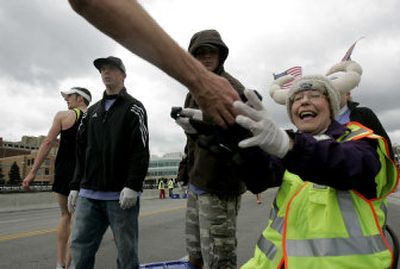Volunteers keep the race running

Their T-shirts may be a different color, but the volunteers who keep nearly 45,000 Bloomies running smoothly are as big a part of the event as the runners.
“I love the masses of people,” said Wanda Burns, one of about 35 volunteers getting ready for the first wave of runners to shed their microchips on the Monroe Street Bridge.
“To be behind the scenes is even as good as running it,” she said.
By its 10th year, the 1986 Bloomsday used about 5,000 volunteers to help navigate more than 45,000 runners to the finish. Today, the number of volunteers remains at about that level.
“Without the volunteers this race wouldn’t go. It’s just as simple as that,” said Dr. Dick Howland.
He’s been both a volunteer and a runner since the beginning.
“I became a volunteer involuntarily at the finish line because people were collapsing because of the heat,” Howland said.
Every year since then, he’s shuttled elite runners to the airport, making sure they get to the race on time and catch their planes home.
Many of the first trips were made by high school students who drove runners in their parents’ cars.
A lot has changed since 1977, and sponsors now provide vans that he can dispatch at a minute’s notice.
“Back then I was looked on as a weird duck for running,” he said. He even had to special order his Nikes from Oregon because none of the stores here sold them.
The popularity of both jogging and Bloomsday have soared since then, and on Friday afternoon Howland had just received a list of about 120 pro runners and wheelchair racers he and his wife would get downtown.
“I get to have a few minutes to converse with them. That’s exciting,” Karen Howland said on race day while juggling questions from runners and a long list of flight times in the lobby of the Doubletree Hotel. She’s volunteered for 22 years.
While a board of directors and a salaried race director steer the ship, it’s up to unpaid helpers to take care of everything else. From medical professionals who staff first-aid tents to people who help with the mailings, the vast majority of the work is handled by volunteers.
Among long rows of tables, Rick Taylor helped hand out T-shirts with his four children ages 9 to 14.
“It’s something we do together,” Taylor said.
Some volunteers said helping out was just plain fun, and others said they wanted to be a part of such a large event.
When asked why he’s volunteered for so long, Howland just shrugged and looked off.
“It’s my city, it’s my sport.”